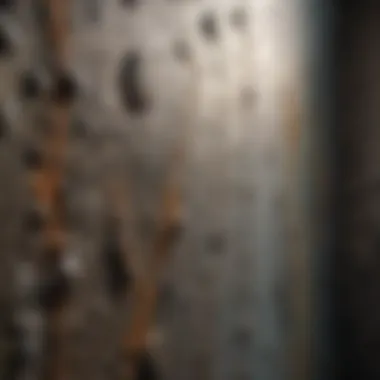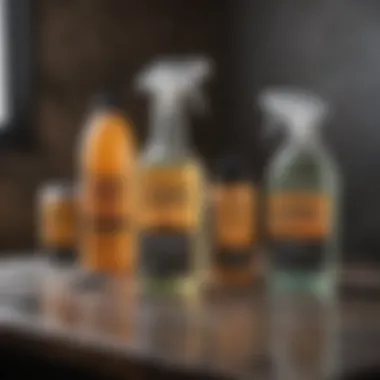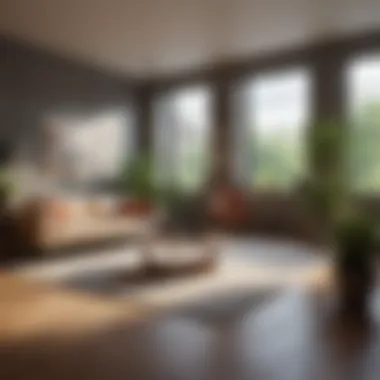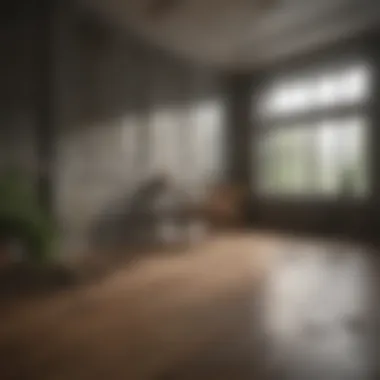Effective Methods for Eliminating Mold and Mildew


Intro
Mold and mildew are persistent problems in various environments, both residential and commercial. They thrive in moist and warm conditions, posing risks not only to property but also to health. Understanding how to effectively eliminate mold and mildew can transform the quality of our living and working spaces. This article will highlight key points around the biological factors leading to mold growth, preventive measures, and practical cleaning solutions to combat these issues.
Understanding Mold and Mildew
Mold refers to a diverse group of fungi that plays an essential role in the ecosystem, breaking down organic matter. However, when it grows indoors, it can cause significant damage and health concerns. Mildew is a specific type of mold, commonly found in the form of a thin, white film. Knowing the differences helps in identifying the right approach to deal with them.
Mold and mildew prefer dark, damp places. Common areas prone to these fungi include bathrooms, basements, and kitchens. Moisture is their primary source of sustenance. To combat them, it is essential to control excessive dampness and humidity levels.
"A proactive approach to humidity management is key in preventing mold growth."
Key Strategies for Mold Prevention
Preventive measures are crucial in keeping mold and mildew under control. Here are effective methods:
- Control Humidity: The humidity level should be kept below 50% in living areas. Using dehumidifiers can help maintain appropriate moisture levels.
- Proper Ventilation: Ensuring good airflow in problem areas can help reduce moisture accumulation. This may include using exhaust fans in kitchens and bathrooms.
- Prompt Repairs: Fixing leaks in roofs, pipes, and walls quickly will stop moisture from enabling growth.
- Mold-Resistant Materials: Consider using mold-resistant paints or selecting materials specifically designed for areas prone to mold, such as fiber cement siding.
Practical Cleaning Solutions
When mold or mildew is detected, acting fast is important. Use these cleaning strategies to combat the problem effectively:
- Vinegar Solution: The acetic acid in vinegar can kill many types of mold. Apply undiluted vinegar on the surface, let it sit, and wipe clean with water.
- Bleach for Non-Porous Surfaces: A mixture of one cup of bleach to one gallon of water can be used for hard surfaces. Ensure the area is well-ventilated.
- Baking Soda: This common household item can be dissolved in water to create a gentle scrubbing solution. It helps to eliminate odors and can prevent mold from returning.
- Commercial Mold Cleaners: Certain products, like RMR-86 or Concrobium, are specifically designed for mold eradication. Always follow the manufacturer's instructions carefully.
Closure
Mold and mildew are challenges that need attention in both homes and workplaces. By understanding the key factors leading to their growth and implementing effective preventive measures, one can maintain a healthier environment. Through consistent upkeep, you can mitigate the risks posed by these fungi and preserve your property’s integrity. This guide serves as an essential resource for homeowners, interior design enthusiasts, and anyone interested in maintaining clean and safe spaces.
Understanding Mold and Mildew
Understanding mold and mildew is crucial for anyone concerned with maintaining clean and healthy living or working spaces. These fungi thrive in environments with high moisture, often unseen until they cause significant damage. Knowing how they grow and where they appear can lead to more effective prevention and removal. Additionally, understanding mold biology aids in recognizing health risks, making it a key topic in this article.
What are Mold and Mildew?
Mold and mildew are both types of fungi. Mold appears as a fuzzy growth in colors such as green, black, or white, often found on damp surfaces. Mildew, on the other hand, is usually a white or grayish substance that develops on organic materials. Both require moisture to grow, but mildew is typically associated with a flatter appearance while mold has a more three-dimensional structure. The presence of either can signify water damage or excessive humidity, making them critical indicators of environmental conditions.
The Biological Process of Mold Growth
Mold growth is a biological process that starts with spores, which are tiny reproductive units. These spores can be carried by air and enter buildings easily.
If conditions are favorable—specifically, the right temperature and humidity—sporulation occurs. The spores absorb moisture and nutrients from their surroundings. As they multiply, they form visible colonies. Key factors influencing growth include:
- Moisture: High levels help spores germinate.
- Temperature: Most molds thrive between 60°F and 80°F.
- Organic Material: Wood, paper, and fabrics serve as food.
Understanding this process is vital for preventing large infestations.
Common Types of Mold Found Indoors
Various mold species are common in indoor environments. Knowing these can help in identifying potential issues. Some prevalent types include:
- Aspergillus: Found on food and dusty surfaces, can cause allergic reactions.
- Penicillium: Typically appears on damp surfaces and produces a blue-green color.
- Stachybotrys chartarum: Often referred to as black mold, linked with health risks such as respiratory issues.
- Cladosporium: Present in homes during cooler months, typically likes fabrics and wood.


These molds can pose health risks, particularly for individuals with respiratory problems or weakened immune systems.
Understanding these types is essential for recognizing signs of mold problems early and acting promptly.
Causes of Mold and Mildew Proliferation
Understanding the causes of mold and mildew proliferation is crucial for effective mold management. These fungi thrive in environments that provide the right conditions for growth. Identifying the specific elements that contribute to their spread can help homeowners and building managers mitigate risks and maintain a healthy environment. Mold and mildew not only damage property but can also pose serious health risks. Therefore, knowing what leads to their proliferation is the first step in combating them effectively.
Understanding Moisture and Humidity Levels
Moisture and humidity are the primary drivers of mold growth. Mold spores require a certain level of moisture to germinate. When humidity levels exceed 60 percent, the risk of mold development increases significantly. This is particularly relevant in areas with poor insulation or in climates that are naturally humid.
A common misconception is that keeping windows and doors closed will prevent outside moisture from entering. However, this can trap humidity indoors, especially in bathrooms and kitchens where steam and water are prevalent. To monitor humidity levels, using a hygrometer can be beneficial. Keeping indoor humidity below 50 percent can greatly reduce the chance of mold growth.
Identifying Poor Ventilation Issues
Poor ventilation is another critical factor in mold and mildew proliferation. When air does not circulate properly, moisture can accumulate in certain areas, creating a perfect breeding ground for mold. Rooms that are often sealed, such as basements, attics, and bathrooms, tend to suffer from this issue.
Improving ventilation can be achieved by opening windows, using exhaust fans, and ensuring that air can flow freely throughout the space. In some cases, the installation of mechanical ventilation systems may be necessary to ensure a consistent flow of fresh air.
Good ventilation practice can dramatically decrease the chances of mold growth and improve overall indoor air quality.
The Role of Organic Materials in Growth
Mold feeds on organic materials to grow, which includes a variety of substances commonly found in homes. Wood, paper, fabrics, and even some dust particles can act as food sources for mold. When moisture is present, these organic materials become susceptible to mold infestations.
Knowing which materials in your home are prone to mold is vital. It is wise to keep such materials dry and to clean regularly. Using non-porous materials in high-humidity areas can also help reduce the chances of mold establishing itself. Regular inspections and maintenance play important roles in identifying and removing any potential organic matter that could provide a sustenance to mold.
Preventive Measures Against Mold and Mildew
Preventing mold and mildew is an essential aspect of maintaining healthy indoor environments. The initial steps taken can significantly reduce the risks associated with mold growth. Awareness of humidity levels and proper ventilation are crucial in this context. This section explores the methods that are most effective in mitigating the conditions that foster mold proliferation.
Controlling Indoor Humidity
To manage mold effectively, controlling indoor humidity is vital. High humidity creates a suitable environment for mold spores to thrive. Ideally, indoor humidity levels should be between 30% and 50%. Here are some methods to achieve this:
- Use Dehumidifiers: Employing dehumidifiers in damp areas like basements or bathrooms can effectively lower humidity.
- Air Conditioning: Regular use of air conditioning can help regulate humidity levels during warm months.
- Monitor Humidity Levels: Using hygrometers allows homeowners to keep track of humidity fluctuations, helping to take action before mold develops.
Controlling humidity is not just about comfort; it is about preventing potential health issues linked to mold exposure. High humidity can also damage materials in the home, from wood to electronics.
Ensuring Proper Ventilation
Proper ventilation is essential for preventing mold. Stale air retains moisture, which can nurture mold spores. Here are ways to ensure adequate airflow:
- Open Windows: When weather permits, opening windows promotes air circulation, reducing humidity levels inside.
- Install Exhaust Fans: In areas like kitchens and bathrooms, exhaust fans help eliminate excess moisture produced through cooking and showering.
- Use Ceiling Fans: Ceiling fans can facilitate air movement, thus lowering moisture accumulation levels.
Taking these simple steps can significantly improve air quality indoors and decrease the chances of mold establishment.
Regular Maintenance and Inspection
Regular maintenance and inspections are integral to mold prevention strategies. Catching potential moisture problems early prevents larger issues later. Consider these practices:
- Check for Leaks: Regularly inspect pipes, roofs, and windows for leaks that can introduce moisture.
- Clean Gutters: Keeping gutters clean can prevent water overflow, which may seep into interiors, increasing humidity.
- Inspect for Mold: Conduct routine checks in areas prone to dampness, such as crawl spaces and behind appliances.


By incorporating these inspection strategies into routine home maintenance, homeowners can ensure healthier living spaces devoid of mold growth.
Chemical Solutions for Mold Removal
Chemical solutions are crucial in the fight against mold and mildew. These products target the underlying biology of mold fungi, effectively removing existing growth and preventing recurrence. Understanding the advantages and limitations of various chemical solutions can greatly impact the effectiveness of cleaning efforts.
Using Commercial Mold Cleaners
Commercial mold cleaners are specifically formulated to eliminate mold and mildew. They often contain strong chemicals such as quaternary ammonium compounds or hydrogen peroxide. These ingredients can penetrate porous surfaces, allowing for deeper cleaning. When using commercial products, it is essential to follow the manufacturer's directions for maximum efficacy. This ensures proper application and safety during use.
It's important to wear appropriate protective gear, such as gloves and a mask, to avoid inhaling dangerous fumes during the cleaning process.
While commercial options are widely available, it is advisable to pick a product that suits your particular needs, whether it's for a small area in the bathroom or a more extensive application across larger spaces.
Advantages of Bleach as a Mold Remover
Bleach is often touted as an effective mold remover. Its powerful properties make it capable of killing mold on contact. One of the significant benefits is its ability to sanitize surfaces and eliminate spores, providing a double action against mold growth. If the surface is non-porous, bleach can be very effective; however, it does have limitations.
Bleach does not penetrate porous materials effectively, like wood or drywall. When mold grows in such materials, using bleach may only remove the visible part without addressing the root problem. Therefore, it's important to assess the type of surface before deciding on bleach as a cleaning solution.
Vinegar and Baking Soda: Natural Alternatives
For those who prefer more natural cleaning methods, vinegar and baking soda provide an effective alternative. White vinegar is acidic, which can help to kill approximately 82% of mold species. Its safe composition makes it a good option for many household surfaces.
Baking soda offers a dual purpose when it comes to mold. It not only acts as a surface cleaner but also deodorizes areas affected by mold. When combined with vinegar, the two create a powerful cleaning agent that is non-toxic and safe for home use.
To mix this solution:
- Combine one cup of vinegar with a tablespoon of baking soda in a spray bottle.
- Shake gently to mix.
- Spray onto the affected area and let it sit for about one hour before scrubbing and rinsing.
This method can effectively address small patches of mold and is safer for homes with children or pets.
Understanding the various chemical solutions for mold removal provides insight into effective cleaning strategies. Whether opting for commercial products, bleach, or natural remedies like vinegar and baking soda, homeowners can take effective steps toward maintaining a mold-free environment.
Physical Removal Techniques
Physical removal techniques are crucial for effectively eliminating mold and mildew. Mold can thrive on various surfaces, and understanding how to remove it is essential for maintaining a healthy environment. Physical removal involves direct interaction with the surfaces where mold resides. This section highlights the importance of identifying the right materials, cleaning techniques, and knowing when to seek professional help. Proper execution of physical removal can prevent mold from recurring and protect the integrity of your space.
Identifying Cloth and Porous Materials
Identifying cloth and porous materials is a significant first step in physical removal techniques. Mold often infiltrates fabrics such as curtains, carpets, and upholstery. These materials tend to absorb moisture, creating a conducive environment for mold growth. To assess if these items are affected, look for visible staining or a musty odor, which indicates underlying mold.
When dealing with porous materials, it’s essential to note that conventional cleaning methods may not suffice. In many cases, affected items should be discarded, especially if the mold growth is extensive. Here are some steps to consider:
- Inspect all fabrics thoroughly.
- If mold is present, evaluate the extent of damage.
- Depending on severity, consider dry cleaning or washing with hot water and detergent.
- If items cannot be saved, remove them cautiously to avoid spreading spores.
Cleaning Non-Porous Surfaces Effectively
Cleaning non-porous surfaces effectively is integral to mold removal strategies. Non-porous surfaces include glass, metal, and some plastics. These materials do not absorb moisture, making them easier to clean. Regular cleaning can keep these surfaces free from mold, but if mold does appear, specific techniques should be employed.
Begin by mixing a solution of water and a mild detergent. For tougher mold, a mix of water and vinegar can also work. Follow these steps for effective cleaning:


- Wipe down the surface using a sponge or microfiber cloth.
- Rinse with clean water after scrubbing off the mold.
- Dry the area thoroughly to prevent future growth.
- Consider using a disinfectant spray afterward to kill remaining spores.
These methods should effectively clean non-porous surfaces, mitigating future mold growth.
When to Consider Professional Help
Sometimes, mold infestations can exceed the capacity of common cleaning techniques, especially if they involve extensive areas or hidden locations. It is vital to recognize when to consider professional help for mold removal. Here are some indicators:
- Large area of growth: If the mold covers more than a square meter, it may be best handled by professionals.
- Recurring mold issues: If mold keeps returning after cleaning efforts, this may indicate deeper underlying problems.
- Health concerns: Individuals with respiratory issues or allergies should avoid exposure to mold and seek professional assistance.
Professional mold remediation services can often identify and resolve issues that homeowners might overlook.
- Hidden mold: Mold may grow in places difficult to access, such as behind walls or under flooring.
- Advanced techniques required: Professional services can offer advanced cleaning techniques and materials unavailable to typical consumers.
In summary, physical removal techniques involve identifying the right materials, cleaning methods, and knowing the limits of your capacity for mold removal. Recognizing when to seek professional help is equally essential for ensuring long-term effectiveness in eliminating mold and mildew.
Post-Cleanup Mold Management
Post-cleanup mold management is vital for ensuring a mold-free environment after initial cleaning efforts have been made. Eliminating visible mold is only one part of the process. This section focuses on monitoring and setting up preventative measures to ensure the problem does not return, safeguarding the health of residents and maintaining the integrity of the living or working space.
Monitoring Remaining Areas
Once the mold cleanup is done, it is crucial to monitor the previously affected areas. This step helps ensure that mold does not re-establish itself. Regular checks can identify any signs of moisture. Look for the following signs:
- Dampness or condensation on walls, ceilings, or floors.
- Musty odors that cannot be explained by other sources.
- Discoloration or stains that may indicate microbial growth.
Make a schedule for inspecting areas that were previously infected. This can be weekly for the first month and then monthly afterward. Using a hygrometer can help track humidity levels, keeping them below 60%. High humidity can cause mold spores to thrive.
Setting Up Preventative Measures
Creating a proactive strategy is essential in preventing mold from coming back. Here are effective methods to help maintain a mold-free environment:
- Utilizing Dehumidifiers: These appliances can significantly reduce humidity levels in areas prone to moisture, like basements and bathrooms.
- Improving Ventilation: Ensure that air circulates freely in all areas of the home, especially in spaces like kitchens and bathrooms where moisture is prevalent.
- Routine Maintenance: Regularly check for leaks in plumbing and roof areas. Small leaks can quickly lead to larger mold issues.
- Use of Mold-Resistant Products: When renovating or repairing, consider using mold-resistant paints and materials.
Effective mold management is an ongoing effort that requires vigilance and commitment.
In summary, once mold cleanup is completed, maintaining a mold-free environment involves regular monitoring for potential issues and implementing preventative measures. Homeowners have a responsibility to ensure safe living conditions, particularly after experiencing a mold problem. Taking these steps can foster a healthier atmosphere in every living and working space.
Legal and Health Considerations
Understanding the legal and health implications of mold and mildew is crucial for homeowners and property managers alike. Mold can lead to severe health issues and financial liabilities. Knowing the risks and associated regulations helps in formulating effective action plans for mold management.
Health Risks Associated with Mold Exposure
Mold exposure can result in various health problems. Individuals with allergies, asthma, or other respiratory conditions may experience worsened symptoms. Here are key health risks to consider:
- Allergic Reactions: Mold spores can trigger allergies, leading to sneezing, runny nose, and itchy eyes.
- Respiratory Problems: Persistent exposure may cause chronic coughing, wheezing, and other respiratory complications.
- Toxic Effects: Certain molds produce mycotoxins, which can have toxic effects. Symptoms may range from fatigue to more severe neurological issues in extreme cases.
If you suspect mold growth, addressing it quickly can minimize its impact on health.
Regulations and Mold Removal Protocols
Legal requirements around mold management vary by region. It is essential to know the local laws related to mold remediation and tenant safety. Emphasis on mold removal protocols can help protect your property and residents’ health. Key regulations to consider include:
- Building Codes: Some areas mandate specific standards for indoor air quality and mold prevention in residential and commercial buildings.
- Disclosure Laws: Property owners may be required to disclose known mold issues to buyers or tenants, which can affect property values.
- Remediation Standards: Many jurisdictions have established protocols for the safe removal of mold. These often include using appropriate personal protective equipment and ensuring proper ventilation during cleanup efforts.
Proper management of mold is not only a health issue but also a legal responsibility for property owners.
By following local regulations and understanding the health risks associated with mold exposure, individuals can take informed actions to mitigate these issues. These considerations ensure a safer living and working environment.



